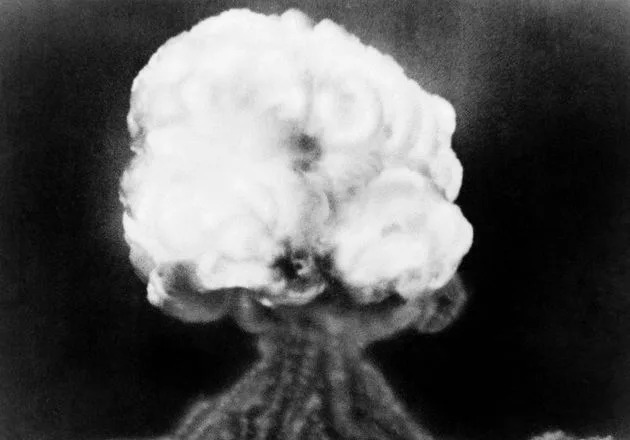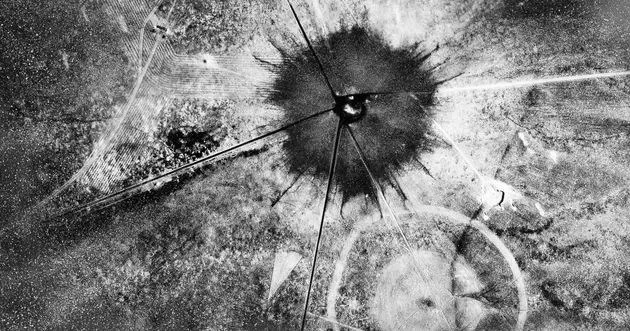Sara Boboltz
Sat, July 22, 2023
Christopher Nolan’s “Oppenheimer,” which dramatizes the Trinity nuclear test carried out almost eight decades ago, is inspiring reflection on one part of the story not covered by his smash hit film: the lingering effects of the experiment on U.S. soil.
New Mexico Sen. Ben Ray Luján (D) called attention to the consequences for his home state in a series of tweets posted Thursday, just ahead of the triumphant opening weekend that “Oppenheimer” shared with the “Barbie” movie.
“It’s critical to note 78 years after the nuclear tests this movie centers on, New Mexico continues to face collateral damage from the Trinity Test site,” Luján wrote.

A mushroom cloud is visible after the first atomic explosion at the Trinity test site near Alamogordo, New Mexico.
“New Mexico was chosen for its uninhabited space, however, nearly half a million people were horribly affected,” he added, citing a Bulletin of the Atomic Scientists article. “Generations of New Mexicans later, thousands of victims and their family members continue to face serious, sometimes deadly health complications.”
Census figures show that 40,000 people lived within a 60-mile radius of the test site, according to the Alamogordo Daily News, a local paper.
A 1990 bill, the Radiation Exposure Compensation Act, compensated many communities affected by U.S. military nuclear explosions — but survivors of the Trinity test were not included.
Luján pointed to the deadly array of cancers that afflicted people who lived in the area for decades afterward, again citing the Bulletin of the Atomic Scientists. For years the senator has been trying, unsuccessfully, to amend the Radiation Exposure Compensation Act to include people in the Trinity fallout zone.
Plans for the blast were kept secret because of the enormous consequence a nuclear weapon would have in World War II; the effects of radiation were not well known at the time.
As a result, those who lived in the surrounding region — many of them Native Americans and other people of color — were startled awake at 5:29 a.m. on July 16, 1945. Inquiring reporters were told that it was a merely “a considerable amount of high explosives and pyrotechnics” that had exploded at an Air Force base.

A 1945 aerial view after the first-ever atomic explosion, at the Trinity test site in New Mexico.
A 1945 aerial view after the first-ever atomic explosion, at the Trinity test site in New Mexico.
Young campers sleeping around 50 miles from the detonation site thought something had exploded at their camp.
“We were all just shocked … and then, all of a sudden, there was this big cloud overhead, and lights in the sky,” one of them, Barbara Kent, told National Geographic in 2021. She was 13 that summer.
“It even hurt our eyes when we looked up. The whole sky turned strange. It was as if the sun came out tremendous,” Kent said.
She and other girls played in the nuclear fallout — white flakes falling from the sky like desert snow. Ten of the 12 campers died before age 40, Vice reported in 2016, with Kent telling the outlet that this was “no coincidence.” She herself had battled cancer.
Much of the fallout went in a northern direction, affecting people as far away as Colorado, Idaho and Montana.
The Tularosa Basin Downwinders Consortium, which seeks federal recognition of Trinity’s effects, has compiled stories from survivors on its website.
Small animals like chickens reportedly died in the wake of the nuclear blast, and infant deaths surged in subsequent months, according to the Bulletin of the Atomic Scientists. People later reported that they continued to consume meat and dairy products from cows within the fallout zone.
But no government agency was keeping track of the broader effects. A 2020 report from the National Cancer Institute suggested that the Trinity test likely contributed to the fallout zone’s cancer rate, but that it was very difficult to estimate the exact number of excess cases given how long ago it happened.
As Luján wrote, “It’s the sad truth that too many have died from the radioactive fallout from these decades-old tests.”
No comments:
Post a Comment